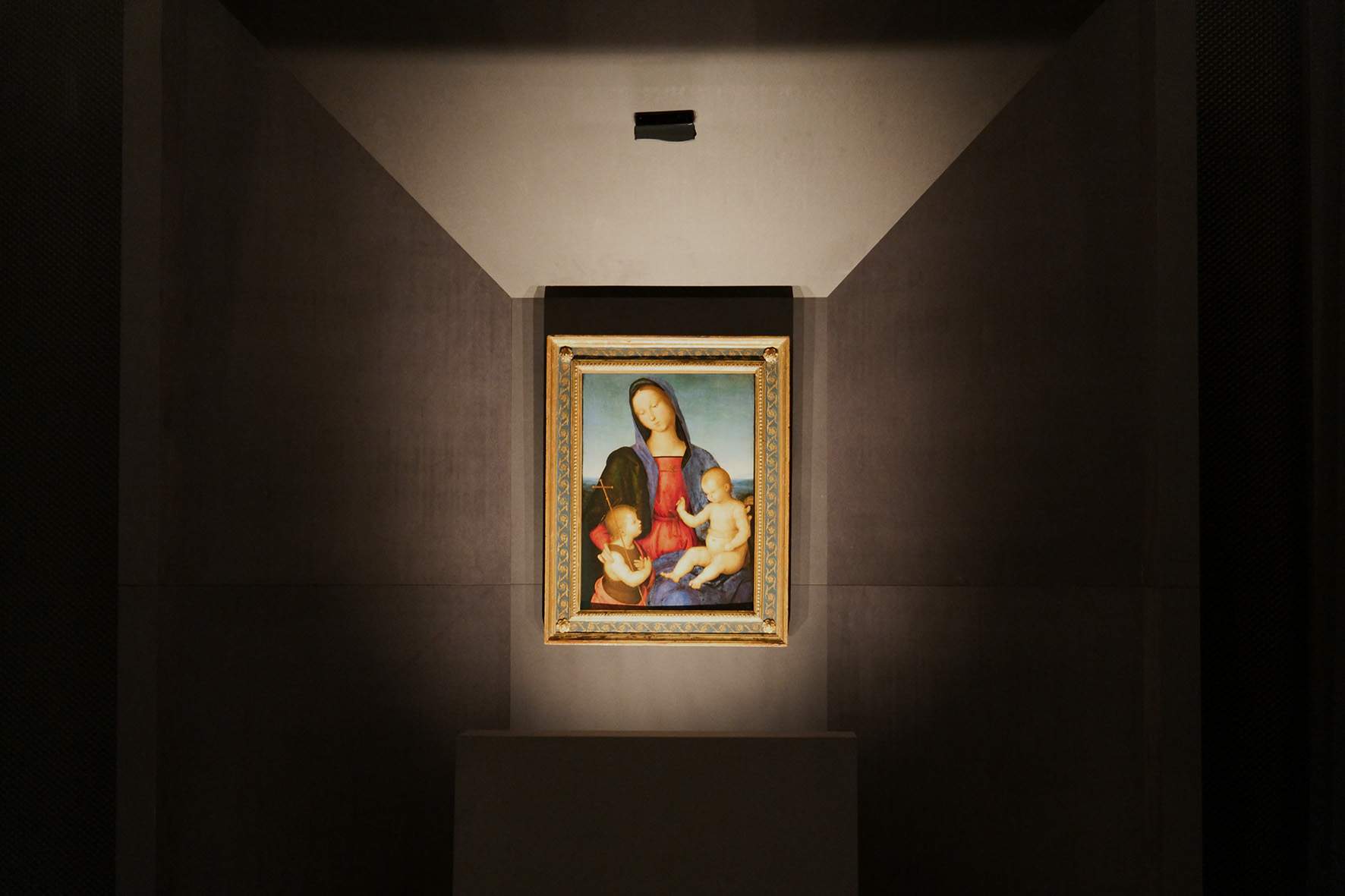The Diotallevi Madonna, an early masterpiece by Raphael, on display in Rimini at the City Museum
One of the most fascinating Madonnas by Raphael Sanzio (Urbino, 1483 - Rome, 1520) is on display in Rimini, where it has returned after 178 years. It is the Diotallevi Madonna, which returned to Romagna yesterday for the celebrations of the 500th anniversary of the Urbino artist’s death: the work, named after its last private owner, Rimini marquis Audiface Diotallevi, arrives on loan from the State Museums of Berlin and can be admired at the City Museum of Rimini until January 10, 2021. The exhibition aims to contextualize the masterpiece in the context of the history of collecting and at the same time to explore Raphael’s early activity, in the context of which the Diotallevi Madonna should be placed.
The work, which can be dated to around 1504, has been in Berlin since 1842, when Audiface Diotallevi sold the work to Gustav Friederich Waagen, an official of the Berlin museums who was the first to recognize the painting as a work by Raphael, since until then it was considered painted by Perugino: thus, Waagen recommended the purchase to the general director Ignaz von Olfers, who arranged to buy the work, which was sold for the sum of 150 thalers luigins (“since this painting,” the museum predicted, “will be one of the most sought-after in the world”). Since then, the greatest critics, from Passavant to Bode, from Cavalcaselle to Morelli, from Fischel to Venturi, from Berenson to Longhi, have taken turns in front of the Diotallevi Madonna, returning a series of suggestions and readings. However, as with so many of Raphael’s Madonnas, it has retained the name of its last private owner. On the other hand, there is no information about its previous history, nor do we know its original provenance.
The panel painting by the young Raphael, in addition to allowing us to admire a still unripe but already full of promise fruit of his art, proves to be a means by which the Museum intends to tell the story of nineteenth-century Rimini, its most eminent personalities, and the collections that reveal a hitherto unsuspected artistic richness that opens ideally to Europe and then to the world.
The Diotallevi Madonna will, as mentioned, be framed in the context of the collecting of Audiface Diotallevi, whose own collection boasted works attributed to Leonardo da Vinci, Bellini, Correggio, and Benvenuto Tisi known as the Garofalo, which later ended up in some of the world’s most important museums. In addition to these are the Crucifix by Giovanni da Rimini, donated by Adauto Diotallevi to the city museum in 1936, and theCoronation of the Virgin by Giuliano da Rimini (better known as the “polyptych of the Duke of Norfolk”) belonging to Audiface himself, which was returned to the city in 1998 thanks to the intervention of the Fondazione Cassa di Risparmio di Rimini. These are panels present today at the City Museum, which will dialogue with Raphael’s Madonna in the exhibition itinerary.
“An encounter,” says Rimini Mayor Andrea Gnassi, “between innovation and tradition, as has often happened throughout Rimini’s history when crucial moments in the city’s history and development have intersected, in the years linked to this work, in the first half of the 19th century, when an enlightened bourgeoisie, between bathhouse establishments and the new theater, was at the center of an epochal change, and also in these years when the city is undergoing a radical change by choosing art and its extraordinary power for its future.”
The exhibition, entitled Raphael in Rimini, and curated by Giulio Zavatta, an art historian at the University of Venice and author of the recent volume on the Diotallevi Madonna, is sponsored by the Municipal Museums of Rimini. The catalog, also edited by Giulio Zavatta, is published by NFC Edizioni. The Rimini firm Cumo Mori Roversi architetti has created the exhibition design that enhances Raphael’s masterpiece and ensures the greatest security in relation to anti-Covid regulations. Opening hours: Tuesdays to Fridays from 9:30 a.m. to 1 p.m. and 4 p.m. to 7 p.m., Saturdays, Sundays and holidays from 10 a.m. to 7 p.m., non-holiday Mondays closed. Visits can only be made by reservation by logging on to the Festival del Mondo Antico website or the Rimini Municipal Museums website. Full ticket euro 8; reduced euro 6; special family ticket euro 20; free for under 6s. The ticket entitles visitors to entry and a tour, lasting about 30 minutes, accompanied by a museum operator. Reserved tours, led by a guide, can be arranged by calling 0541.704421-26 at a cost of euro 50 for the whole group plus reduced entrance fee for each participant. Admission is allowed for groups of up to 14 people.
Cumulative tickets are also provided: admission ticket for Raphael in Rimini exhibition and City Museum with Surgeon’s Domus (10 euros full 8 reduced); admission ticket for Raphael in Rimini exhibition and PART Palazzi dell’Arte Rimini (10 euros full, 8 reduced); admission ticket for Raphael in Rimini exhibition and Municipal Museums (Museum, Domus, PART) 15 full, 9 reduced; guided tour of Raphael in Rimini exhibition and Amintore Galli Theater 10 euros.
 |
| Raphael, Madonna Diotallevi (c. 1504; oil on panel, 69 x 50 cm; Berlin, Bode Museum) |
 |
| The Diotallevi Madonna in the display at the City Museum of Rimini |
 |
| The Diotallevi Madonna, an early masterpiece by Raphael, on display in Rimini at the City Museum |
Warning: the translation into English of the original Italian article was created using automatic tools. We undertake to review all articles, but we do not guarantee the total absence of inaccuracies in the translation due to the program. You can find the original by clicking on the ITA button. If you find any mistake,please contact us.





























